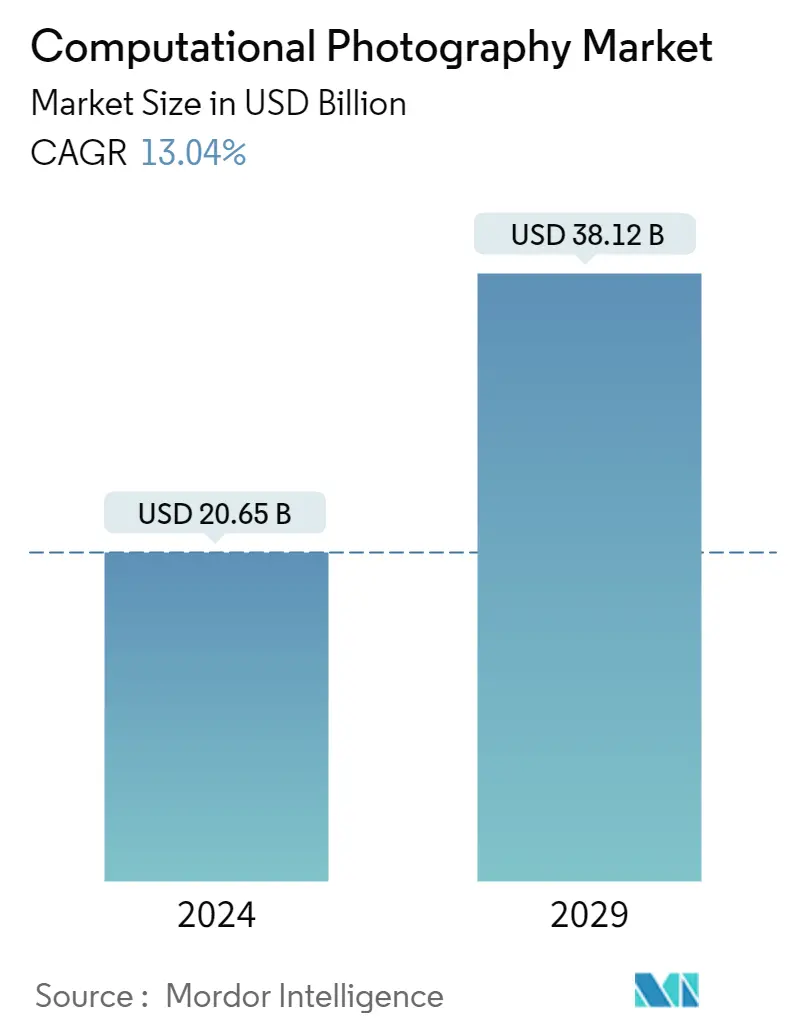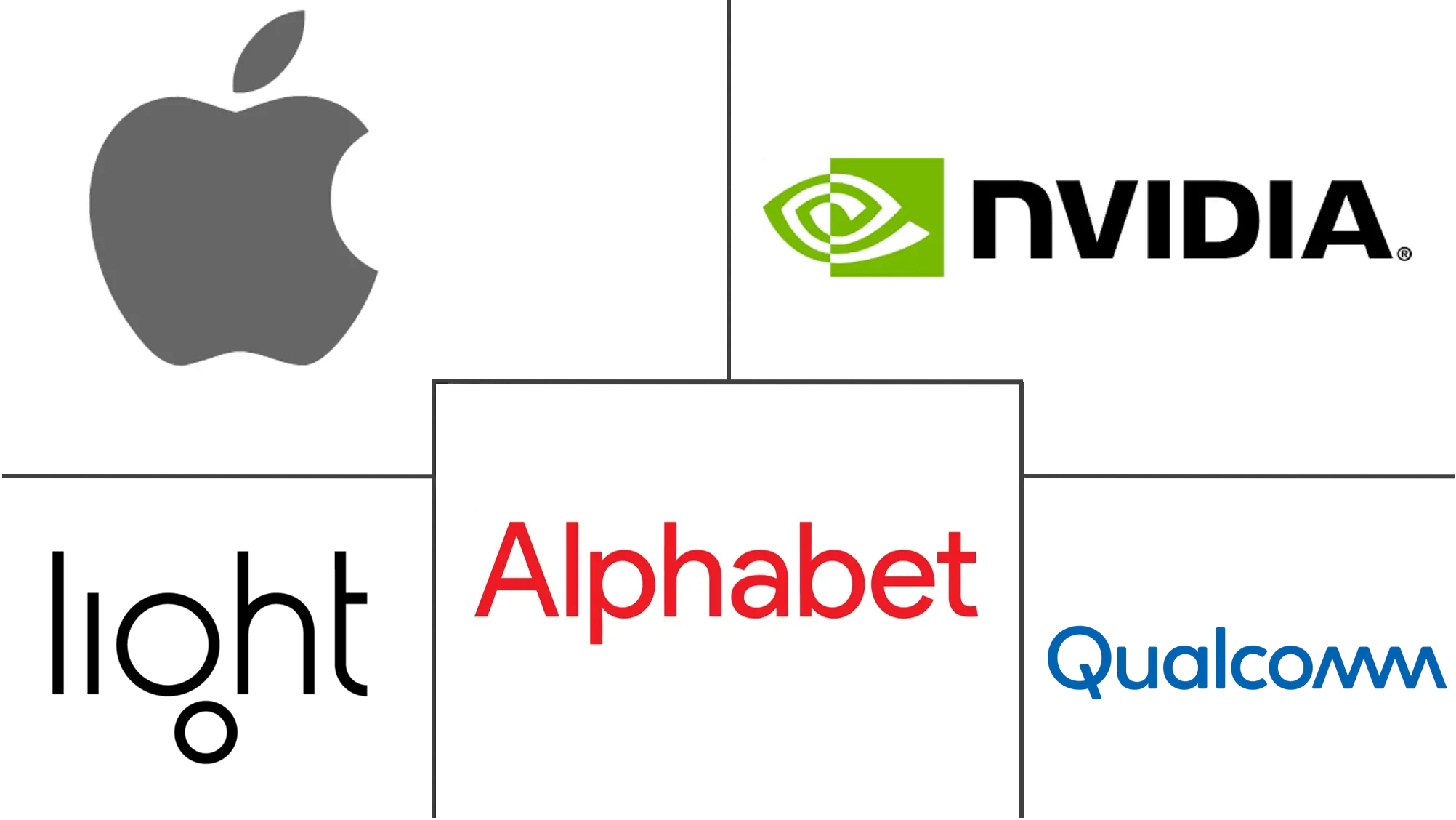Market Size of Computational Photography Industry

| Study Period | 2019 - 2029 |
| Market Size (2024) | USD 20.65 Billion |
| Market Size (2029) | USD 38.12 Billion |
| CAGR (2024 - 2029) | 13.04 % |
| Fastest Growing Market | Asia Pacific |
| Largest Market | North America |
Major Players
*Disclaimer: Major Players sorted in no particular order |
Computational Photography Market Analysis
The Computational Photography Market size is estimated at USD 20.65 billion in 2024, and is expected to reach USD 38.12 billion by 2029, growing at a CAGR of 13.04% during the forecast period (2024-2029).
- Computational photography enhances images through image processing algorithms by reducing motion blur, incorporating artificial depth of field, and improving color, contrast, and light range.
- The market is driven by the increasing use of the Picture Fusion Method to produce high-quality images. Methods that may objectively, methodically, and statistically analyze or evaluate the performance of various fusion technologies have been recognized as urgently needed since picture fusion techniques have developed quickly in multiple applications in recent years. Improving nighttime color images is crucial to computational photography and computer vision.
- The device has sophisticated computational capabilities that are used in computing imaging. By compressing, enlarging, and mosaicking an image, these software solutions enhance and extend the capabilities of computational photography-based devices. Smartphones enable amateur photographers to create photographs of higher quality as computational photography technology develops.
- Additionally, during the forecast period, the industry for computer cameras is anticipated to experience growth due to improvements in sensor image resolution, technological innovation in camera modules, components, and design, and a rise in demand for superior vision technology in the computer vision sector.
- However, the market growth of computational camera modules is held back by high maintenance and manufacturing costs. Mobile phone prices rise as smartphone vendors strive to improve image quality.
- The global market for computational photography was considerably disrupted by the COVID-19 epidemic. The development of new initiatives around the globe halted, which consequently reduced the market for analog semiconductors.
Computational Photography Industry Segmentation
Computational photography refers to the digital image capture and processing techniques that use digital computation instead of optical processes providing its offerings in camera modules and software in the market under smartphone cameras and machine vision camera applications.
The Computational Photography market is segmented by offerings (camera modules, software), type (single- and dual-lens cameras, 16-lens cameras), application (smartphone cameras, machine vision cameras), and geography (North America, Europe, Asia-Pacific, Rest of the World). The market sizes and forecasts are provided in terms of value (USD) for all the above segments.
| By Offerings | |
| Camera Modules | |
| Software |
| By Type | |
| Single- and Dual-Lens Cameras | |
| 16-Lens Cameras |
| By Application | |
| Smartphone Cameras | |
| Machine Vision Cameras | |
| Other Applications |
| By Geography | |
| North America | |
| Europe | |
| Asia-Pacific | |
| South America | |
| Rest of the World |
Computational Photography Market Size Summary
The computational photography market is poised for significant growth, driven by advancements in image processing algorithms that enhance photo quality by reducing motion blur and improving color, contrast, and light range. This technology is increasingly integrated into smartphones, enabling users to capture high-quality images with ease. The market's expansion is fueled by the growing adoption of picture fusion methods and the integration of artificial intelligence and machine learning in camera software, which enhance the capabilities of smartphone cameras without substantial changes to the hardware. Despite the high costs associated with computational camera modules, the demand for superior vision technology in the computer vision sector is expected to propel market growth.
The market landscape is characterized by a fragmented industry with major players like Alphabet Inc., Apple Inc., and Qualcomm Technologies, Inc. actively engaging in strategic partnerships and product launches to strengthen their market presence. The collaboration between Qualcomm and Samsung, along with Apple's introduction of advanced camera systems in their iPhone models, highlights the ongoing innovation in this space. Additionally, the rise of Chinese manufacturers such as Huawei and Xiaomi, which are developing AI-based cameras with advanced chipsets, is contributing to the market's dynamic nature. The adoption of computational photography is also influenced by regional factors, including pricing strategies and consumer awareness, particularly in countries like India, South Korea, and Japan.
Computational Photography Market Size - Table of Contents
-
1. MARKET INSIGHTS
-
1.1 Market Overview
-
1.2 Industry Value Chain Analysis
-
1.3 Industry Attractiveness - Porter's Five Forces Analysis
-
1.3.1 Threat of New Entrants
-
1.3.2 Bargaining Power of Buyers/Consumers
-
1.3.3 Bargaining Power of Suppliers
-
1.3.4 Threat of Substitute Products
-
1.3.5 Intensity of Competitive Rivalry
-
-
1.4 Assessment of the Impact of COVID-19 on the Industry
-
-
2. MARKET SEGMENTATION
-
2.1 By Offerings
-
2.1.1 Camera Modules
-
2.1.2 Software
-
-
2.2 By Type
-
2.2.1 Single- and Dual-Lens Cameras
-
2.2.2 16-Lens Cameras
-
-
2.3 By Application
-
2.3.1 Smartphone Cameras
-
2.3.2 Machine Vision Cameras
-
2.3.3 Other Applications
-
-
2.4 By Geography
-
2.4.1 North America
-
2.4.2 Europe
-
2.4.3 Asia-Pacific
-
2.4.4 South America
-
2.4.5 Rest of the World
-
-
Computational Photography Market Size FAQs
How big is the Computational Photography Market?
The Computational Photography Market size is expected to reach USD 20.65 billion in 2024 and grow at a CAGR of 13.04% to reach USD 38.12 billion by 2029.
What is the current Computational Photography Market size?
In 2024, the Computational Photography Market size is expected to reach USD 20.65 billion.

